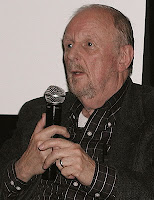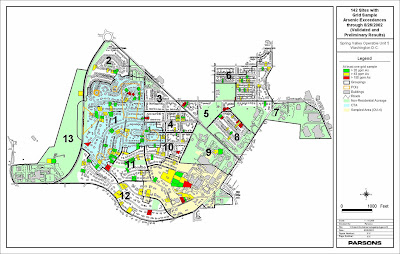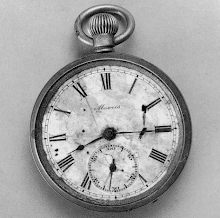Operating under tight safety restrictions, the U.S. Army Corps of Engineers yesterday began excavating what it calls the "last known burial pit" of World War I chemical munitions in Northwest Washington's Spring Valley neighborhood. The Army expects to excavate at least fifteen 75mm artillery rounds -- a dozen or more with mustard gas and three with arsine, both toxic chemical agents -- buried in the affluent residential neighborhood that was once a site for developing and testing chemical weapons ... Washington Post (October 30, 2007: pg. B-1)
Oct 30, 2007
Oct 4, 2007
#1
Approaching two poisoned properties in Spring Valley from the south on Glenbrook Road:
"Arsine is a colorless, flammable gas which is highly toxic in certain concentrations. Although it has a garlic-like or fishy odor, odor is not an adequate indicator of arsine's presence. Because arsine is nonirritating and produces no immediate symptoms, persons exposed to hazardous levels may be unaware of its presence."
Neil Kerwin, President
American University
September 27, 2007
"Arsine is a colorless, flammable gas which is highly toxic in certain concentrations. Although it has a garlic-like or fishy odor, odor is not an adequate indicator of arsine's presence. Because arsine is nonirritating and produces no immediate symptoms, persons exposed to hazardous levels may be unaware of its presence."
Neil Kerwin, President
American University
September 27, 2007
#3
Space between the houses on Glenbrook Road. NOTE: a stairway to the soccer field of the American University campus is visible in the background.
#4
The abandoned house at 4825 Glenbrook Road. A temporary aluminum-plated structure, built to withstand the exposive force of an artillery shell as well as chemical releases, is on the right.
#5
Another view (from the north) of the $795,000 containment structure where workers will sift through unearthed materials buried by the Army at the end of World War I ninety years ago.
#7
AU campus directly behind poisoned Glenbrook Road properties
"The US government considers lewisite to be a weapon of mass destruction. Obtaining precise data on current lewisite production and disposition is difficult because of government restrictions (especially since 9/11) pertaining to information on such weapons. This secrecy impedes the ability of both public and private agencies to evaluate the remediation needs of areas that may be polluted with lewisite residues. The unwillingness of the US Army, for example, to release all documents pertaining to work at American University greatly hinders the remediation work at Spring Valley. There are no accurate estimates as to the quantity of lewisite and related compounds actually buried there, or locations of burial pits."WMDs in our Backyards
Earth Island Journal ~ Winter 2005, vol. 19, no.
#11
Wooden fence separating ambassador's residence from the contaminated property at 4825 Glenbrook Road.
#13
#14
The residence at 4825 Glenbrook Road with the aluminum-plated, containment structure on the left (south) side. According to the Army, should the structure wall be penetrated, "negative air pressure" will keep poisonous gas from escaping. A vapor containment cover is draped over the outside of the entire unit.
Oct 3, 2007
Seventy-Year Spring Valley AUES Coverup Blown on January 5, 1993
World War I munitions were found buried in a neighborhood bordering American University ... by the W.C. & Miller Development Co. on Jan. 5 while working at 511 52nd Court, AU media relations director David Taylor said ... "Residents living within 300 feet of the munitions site were forced to evacuate their homes immediately after the discovery, on the off-chance one of the explosives would detonate," Taylor said ... "This isn't an odd situation at all ... It's probably an isolated site that was missed during the Army cleanup after World War I," he said.
"Based on their involvement in the chemical weapons program conducted at AU, both the United States and AU had sufficient knowledge of the presence of contamination to require that the Spring Valley site be identified to EPA ... There is no excuse for their failure to file the required report in 1986 when both AU and the United States received information from the analysis of aerial photography and a search of the records that contamination was likely present in Spring Valley. It appears that, in 1986, the United States and American University jointly decided to ignore the contamination and the potential harm it was causing instead of making the required Superfund report."
William C. Harrop, President
Spring Valley - Wesley Heights Citizens Association
DC Subcommittee of the Committee on Government Reform
July 27, 2001 (pg. 32)
"Based on their involvement in the chemical weapons program conducted at AU, both the United States and AU had sufficient knowledge of the presence of contamination to require that the Spring Valley site be identified to EPA ... There is no excuse for their failure to file the required report in 1986 when both AU and the United States received information from the analysis of aerial photography and a search of the records that contamination was likely present in Spring Valley. It appears that, in 1986, the United States and American University jointly decided to ignore the contamination and the potential harm it was causing instead of making the required Superfund report."
William C. Harrop, President
Spring Valley - Wesley Heights Citizens Association
DC Subcommittee of the Committee on Government Reform
July 27, 2001 (pg. 32)
AU Experiment Station ~ 1918
 Each morning George Temple fell in line in front of the History Building (Hurst Hall) for roll call. It was here that the calls were issued for volunteers to submit to being burned by experimental gases. Temple responded to that call seven times ... Most gas victims were stray dogs. "Hundreds and hundreds of them" running loose in the streets were picked up and gassed. Scientists and doctors studied the canines' reactions and the carcasses were shaved and dissected for examination and testing.
Each morning George Temple fell in line in front of the History Building (Hurst Hall) for roll call. It was here that the calls were issued for volunteers to submit to being burned by experimental gases. Temple responded to that call seven times ... Most gas victims were stray dogs. "Hundreds and hundreds of them" running loose in the streets were picked up and gassed. Scientists and doctors studied the canines' reactions and the carcasses were shaved and dissected for examination and testing.The Eagle ~ January 15, 1965
Aerial View of Camp AU
 Through 1918, the campus was anything but academic. Abandoned barracks were coverted to kennels to house dogs used in toxicological research. Trenches and "bomb pits," used for exploding chemical shells filled with toxic materials, scarred the campus ... When the "occupation" ended, one "permanent" and 70 wooden buildings remained ... In the war's aftermath, the DC Fire Department burned most of the wooden structures. The buildings had been so impregnated by toxic ingredients that they were unsuitable for student use.
Through 1918, the campus was anything but academic. Abandoned barracks were coverted to kennels to house dogs used in toxicological research. Trenches and "bomb pits," used for exploding chemical shells filled with toxic materials, scarred the campus ... When the "occupation" ended, one "permanent" and 70 wooden buildings remained ... In the war's aftermath, the DC Fire Department burned most of the wooden structures. The buildings had been so impregnated by toxic ingredients that they were unsuitable for student use.The Eagle ~ May 23, 1969

The Hole Called "Hades"
The 1918 Sgt. Maurer photograph ... depicts disposal in a pit area of bottles and carboys, presumably containing mustard gas. The inscription on the back of the photograph says in effect: "This pit, the most feared and respected place on the grounds. The bottles are full of Mustard to be destroyed here in Death Valley in the hole called 'Hades'." A photogrammetry exercise in 2000, performed by the EPA Photographic Interpretation Center (EPIC), determined that the most likely location of the pit in the photograph was on Glenbrook Road near the backyard of the property* where Pit 3 is located. Two sheds and a utility line are clearly visible in the photograph.
Spring Valley RABMeeting Minutes
November 13, 2007 (pg. 16)
_______________
*
Editor's Note: The official, Army Corps line (locating the Sgt. Maurer
burial pit in the backyard of 4825 Glenbrook Road) is belied by the 3rd
corrected, EPA EPIC photogrammetry study in December 2000, which
concluded that the most likely location of the 1918 pit was on the
American University campus opposite/west of Watkins building and under
the grassy strip alongside Kreeger Roadway. Please see map posted here
...
http://wmdindc.blogspot.com/2012/01/overlooked-photo-analysis-put-sgt.html
http://wmdindc.blogspot.com/2012/01/overlooked-photo-analysis-put-sgt.html
Journal Records Mass Weapons Dump "Far Back" on AU Acres
Comment from Ginny Durrin, Audience Member: "Although speculation and stories regarding uninvestigated burial pits are not considered solid evidence, Spring Valley residents deserve to have these allegations taken seriously ... In the 1986 EPIC report, a U.S. Army historian referred to Mr. [Arthur] Osborne as an overwrought Victorian writer who spouted nonsense in his newspaper article [see Camp American University Historical Search by J.W. Williams, 10/26/86, pgs. 44 - 47]. In reality, Mr. Osborne was a highly-educated ordained minister who was part of the AU inner circle for many years as a secretary and a prominent person on the AU campus. Believing Mr. Osborne’s exact words isn’t necessary, but his story should not be discounted."
Restoration Advisory Board
Meeting Minutes
September 8, 2009 (pg. 17)
 There were munitions on hand, including multiplex gas and an invented explosive many times dynamite, valued at $800,000 ... The numerous collections on hand, just ready to go overseas, was valued at nothing now but the expense of putting them away. As "this was to be the last war," permission was given to go far back on the University acres, to dig a pit deeper than the one into which Joseph was cast, bury the munitions there and cover them up to wait until the elements shall melt with fervent heat, when the earth and the works therein shall be burned up.
There were munitions on hand, including multiplex gas and an invented explosive many times dynamite, valued at $800,000 ... The numerous collections on hand, just ready to go overseas, was valued at nothing now but the expense of putting them away. As "this was to be the last war," permission was given to go far back on the University acres, to dig a pit deeper than the one into which Joseph was cast, bury the munitions there and cover them up to wait until the elements shall melt with fervent heat, when the earth and the works therein shall be burned up.
Arthur Osborne
The Courier ~ (April 1921: pg. 7)
Restoration Advisory Board
Meeting Minutes
September 8, 2009 (pg. 17)
 There were munitions on hand, including multiplex gas and an invented explosive many times dynamite, valued at $800,000 ... The numerous collections on hand, just ready to go overseas, was valued at nothing now but the expense of putting them away. As "this was to be the last war," permission was given to go far back on the University acres, to dig a pit deeper than the one into which Joseph was cast, bury the munitions there and cover them up to wait until the elements shall melt with fervent heat, when the earth and the works therein shall be burned up.
There were munitions on hand, including multiplex gas and an invented explosive many times dynamite, valued at $800,000 ... The numerous collections on hand, just ready to go overseas, was valued at nothing now but the expense of putting them away. As "this was to be the last war," permission was given to go far back on the University acres, to dig a pit deeper than the one into which Joseph was cast, bury the munitions there and cover them up to wait until the elements shall melt with fervent heat, when the earth and the works therein shall be burned up.Arthur Osborne
The Courier ~ (April 1921: pg. 7)
Livens Gun Pit: Yesterday & Today
Livens gun pit behind AU intramural soccer field (2014)
"After the discovery of the Livens gun pit [in August 2002 on Woodway Lane], Corps of Engineers personnel were able to determine the exact direction of fire. This direction of fire confirms other historical evidence about the use of this range. Based on historic maps and aerial photos it is believed that there were only three impact areas associated with this range. Two of these, POI 18 and AOI 12, are located east of Dalecarlia Parkway...."
"... The possible impact area west of Dalecarlia Parkway has been designated 'AOI 6 - Dalecarlia Impact Area.' Confirming this assumption, munitions debris has been previously identified in this area west of Dalecarlia Parkway on the Federal Property."
Concrete trough on left is Livens gun pit at AUES in 1918
Photographs now stored at the Army Chemical School in Fort Leonard Wood, Missouri, document firing Livens projectors and Stokes mortars toward the Dalecarlia Reservoir. Stokes mortars and Livens projectors have been found on Sedgewick Street, 52nd Court and next to the Dalecarlia Reservoir, both inside and outside the firing range.Vast Chemical Weapon Stockpiles Never Used in World Wars
.jpg)
By 1918, the U.S. was producing more chemical weapons than any of the other major combatants. In addition to mustard and other gases used on the battlefield, the U.S. developed and manufactured an organic arsenic compound that became known as Lewisite, named for Captain W. Lee Lewis who first determined its structure of a compound synthesized by Father Julius Nieuwland 15 years earlier. He mixed acetylene and arsenic trichloride with nearly suicidal result.
 In the years between the World Wars, most military leaders were averse to using chemical weapons, but decided they needed to have these weapons in case the other side used them. So most of the major combatants in World War II built up stockpiles of chemical weapons that were never used. As was true in World War I, the only Lewisite casualties in World War II were plant workers who made the poison and soldiers who "volunteered" to test the weapons.
In the years between the World Wars, most military leaders were averse to using chemical weapons, but decided they needed to have these weapons in case the other side used them. So most of the major combatants in World War II built up stockpiles of chemical weapons that were never used. As was true in World War I, the only Lewisite casualties in World War II were plant workers who made the poison and soldiers who "volunteered" to test the weapons.Lewisite: Never-Used Chemical Weapon
Becomes Hazardous Waste
Chemical Engineering Progress
December 2005
Lewisite Lost at Sea
 "This report updates the general locations, types, and quantities of chemical munitions or chemical agents (CA), collectively referred to as chemical warfare material (CWM), disposed of in U.S. coastal waters ... The Department of Defense's research into sea disposal of chemical warfare material has identified approximately 30,000 tons of disposed CA at 21 sites in U.S. coastal waters."
"This report updates the general locations, types, and quantities of chemical munitions or chemical agents (CA), collectively referred to as chemical warfare material (CWM), disposed of in U.S. coastal waters ... The Department of Defense's research into sea disposal of chemical warfare material has identified approximately 30,000 tons of disposed CA at 21 sites in U.S. coastal waters."2007 Annual Defense Environmental Report to Congress
[Appendix S: Sea Disposal of Military Munitions]
Oct 2, 2007
In Memoriam
b.jpg) This site is dedicated to the memory of Charlie Bermpohl (1935 - 2010) who chronicled the cleanup of buried World War I munitions in Spring Valley for The Northwest Current.
This site is dedicated to the memory of Charlie Bermpohl (1935 - 2010) who chronicled the cleanup of buried World War I munitions in Spring Valley for The Northwest Current.+ + + + + + +
"Don't adopt a strong position on something you understand imperfectly and then publicize it ... Don't make a judgment on something you believe to be true because of your trust in the people, or person, who gave you the information and not on your own knowledge of what was involved ... Draw yourself away from being convinced, be an independent observer, write without a point of view, don't adopt heroes who become your mentors on these subjects, learn."
Charlie Bermpohl
May 29, 2008
Subscribe to:
Posts (Atom)



























